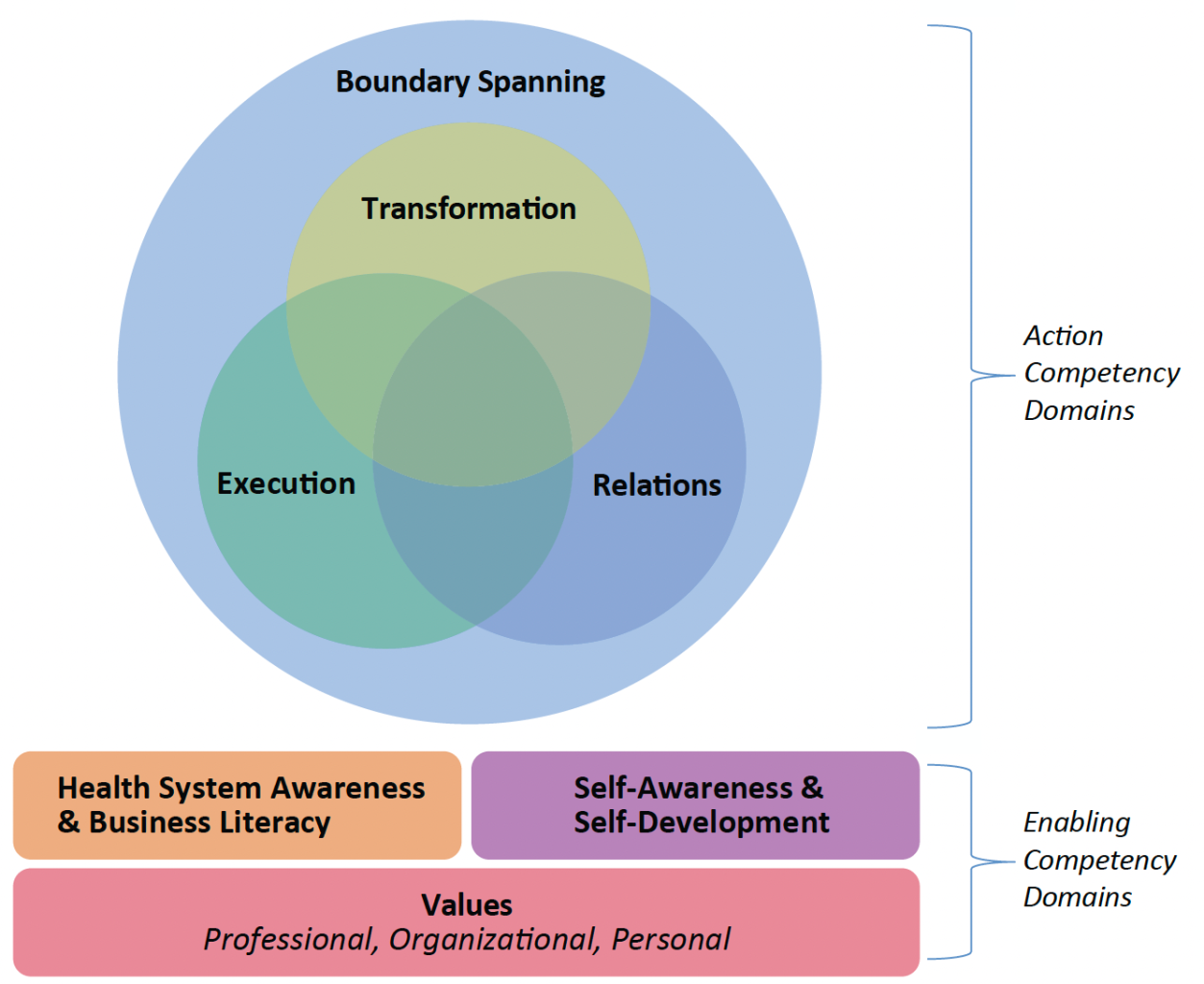The HPM MHA student competency model is made up of 20 competencies grouped into seven specific domains.

Action Competency Domains
- Boundary Spanning
- Transformation
- Execution
- Relations
Enabling Competency Domains
- Health System Awareness and Business Literacy
- Self-Awareness
- Values
Boundary Spanning
| Competency | Description |
|---|---|
| Organizational Awareness | The ability to understand and learn the formal and informal decision-making structures and power relationships in an organization or industry (e.g., stakeholders, suppliers). This includes the ability to identify who the real decision makers are and the individuals who can influence them, and to predict how new events will affect individuals and groups within the organization. |
| Community Collaboration | The ability to align one's own and the organization's priorities with the needs and values of the community, including its cultural and ethnocentric values, and to move health forward in line with population-based wellness needs and national health agenda. |
| Relationship and Network Development | The ability to establish, build and sustain professional contacts for the purpose of building networks of people with similar goals and that support similar interests. |
Execution
| Analytical Thinking | Developing a deeper understanding of a situation, issue or problem by breaking it down or tracing its implications step-by-step. It includes organizing the parts of a situation, issue, or problem systematically; making systematic comparisons of different features or aspects; setting priorities on a rational basis; and identifying time sequences, casual relationships, or if-then relationships. |
| Accountability | The ability to hold people accountable to standards of performance or ensure compliance by effectively and appropriately using the power of one's position or personality, with the long-term good of the organization in mind. |
| Performance Measurement | The ability to understand and use statistical and financial metrics and methods to set goals and measure clinical as well as organizational performance; commits to an deploys evidence-based techniques. |
| Process and Quality Improvement | The ability to analyze and design or improve an organizational process, including incorporating the principles of high reliability, continuous quality improvement, and user-centered design. |
| Communication - Writing | The ability to use written communications in formal and informal situations to convey meaning, build shared understanding, and productively move agendas forward. |
| Communication - Speaking and Facilitating | The ability to use spoken communications in formal and informal situations to convey meaning, build shared understanding, and productively move agendas forward. |
Health System Awareness and Business Literacy
| Financial Skills | The ability to understand and explain financial and accounting information, prepare and manage budgets, and make sound long-term investment decisions. |
| Human Resources Management | The ability to implement staff development and other management practices that represent contemporary best practices, comply with legal and regulatory requirements, and optimize the performance of the workforce, including performance assessments, alternative compensation and benefit methods, and the alignment of human resource practices and processes to meet the strategic goals of the organization. |
Relations
| Team Leadership | The ability to lead groups of people toward shared visions and goals, from forming a team that possesses balanced capabilities, to setting its mission, values, and norms, and holding team members accountable individually and as a group for results. |
| Impact and Influence | The ability to persuade, convince, influence, or impress others (individuals or groups) in order to get them to go along with or to support one’s opinion or position. The “key” is understanding others’ interests and motivations, in order to have a specific impact, effect, or impression on them and/or convince them to take a specific course of action. |
Self-Awareness
| Self-Confidence | A belief in one’s own capability to successfully accomplish their work. This includes confidence in one’s ability as expressed in increasingly challenging circumstances, and confidence in one’s decisions or opinions. |
| Self-Awareness | The ability to have an accurate view of one’s own strengths and development needs, including the impact that one has on others. A willingness to address development needs through reflective, self-directed learning, and by trying new approaches. |
Transformation
| Strategic Orientation | The ability to consider the business, demographic, ethno-cultural, political, and regulatory implications of decisions and develop strategies that continually improve the long-term success and viability of the organization. |
| Information Seeking | An underlying curiosity and desire to know more about things, people, and issues, including the desire for knowledge and staying current with health, organizational, industry, and professional trends and developments. It includes pressing for more precise information; resolving discrepancies by asking a series of questions; and scanning for potential opportunities or information that may be of future use, as well as staying current and seeking best practices for adoption. |
| Change Leadership | The ability to energize stakeholders and sustain their commitment to changes in approaches, processes, and strategies. |
| Innovation | The ability to approach one’s work and the organization in new and breakthrough ways, including applying complex concepts, developing creative new solutions, or adapting previous solutions in promising new ways. |
Values
| Professional and Social Responsibility | The demonstration of ethics, sound professional practices, social accountability, and community stewardship. Acting in ways that are consistent with one's values and what one says is important. |